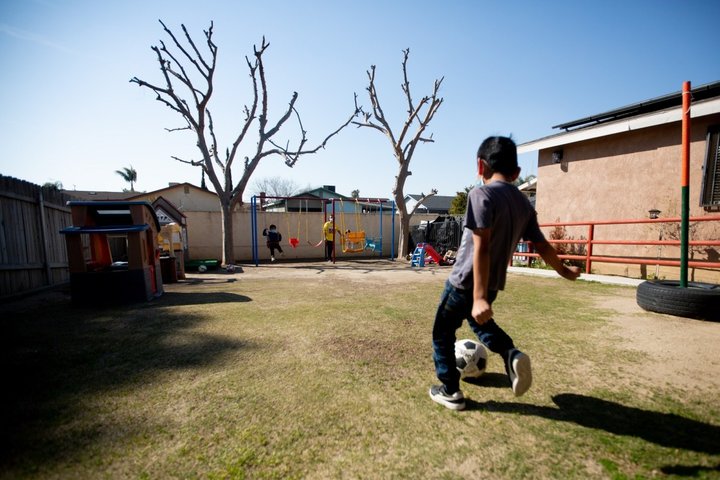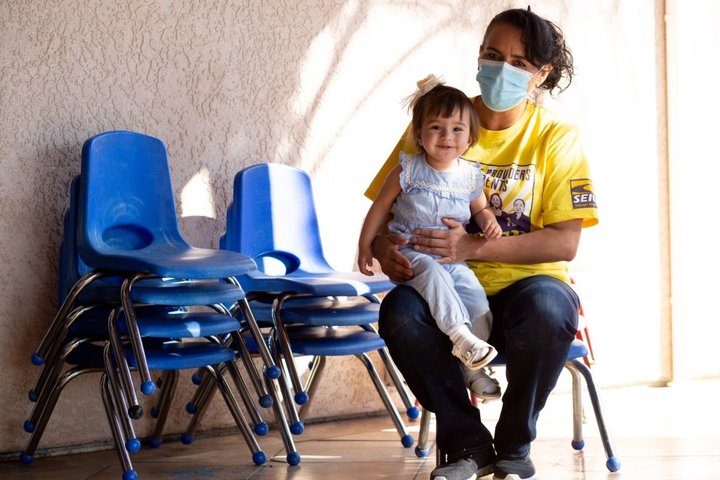
Children play in the backyard of Ana Ballesteros home where she runs a day care in Delano on Feb. 26, 2021. Photo by Shae Hammond for CalMatters
###
Ana Bertha Ballesteros had to close her home child care in Delano for more than two weeks around Thanksgiving when COVID-19 came to her center. A child and their family were exposed and tested positive. Then Ballesteros did too.
She is terrified of it happening again.
“I’m very concerned,” Ballesteros said. “Thank God I made it for those 14 days but if we were to have another exposure what is going to happen with me and my family? It’s our only income.”
California child care sites have reported to the state 12,032 cases of COVID-19 and 30 related deaths since the pandemic began. Infections have occurred at nearly one-fifth of all centers or homes — among staff, children or their parents. None of the 30 deaths have been children.
The pandemic has led to multiple child care problems in California, including a shortage of care centers, a non-negligible risk of infection even with costly precautions in place, and hardships for child care providers themselves.
Kern County, where Ballesteros operates, has seen 425 reported coronavirus cases at child care centers. Los Angeles County leads the state with 2,702 cases. The state is not releasing the names of the child care sites where infections have been reported because the Dept. of Social Services says they are “exempt from disclosure” under state law.

Ana Ballesteros sits for a portrait with her grand daughter Ava Dominguez at Ana’s Family Child Care in Delano on Feb. 26, 2021. Photo by Shae Hammond for CalMatters
Whether those numbers are good or bad is almost impossible to say at this point, said Dr. Ilan Shapiro, pediatrician with AltaMed Health Services and Fellow of the American Academy of Pediatrics. The circumstances at each center can vary widely, and there is not yet reliable comparison data from other states.
“In general, kids need to be in these types of centers because it helps their social development and health,” said Shapiro. “It also creates a safety net for the kids.”
He encourages parents to learn about what providers will do there is an exposure to the infection and question what protocols they follow to prevent them: washing hands, wearing masks, taking temperatures, using protective equipment.
“We have seen more cases. Kids are getting sick,” he said. “And we know that if at home we are taking care of each other and at school (or day care) they are wearing their masks and washing their hands and doing everything appropriately, that reduces the risk of getting COVID.”
California allowed child care sites to remain open throughout the pandemic — following cleaning and social distancing guidelines. As Scott Murray, spokesman for the Department of Social Services, wrote in an email: “Families need a safe place for their children while they work.”
An estimated 60% of Californians already lived in a child care desert before the pandemic.
Since the pandemic began, 2,160 California child care sites have closed permanently, representing a loss of 33,387 child care slots for children. Another 8,000 facilities — both large centers and family homes — have temporarily closed across the state as of October, according to a report given to a Senate budget committee last month.
That poses a growing problem: An estimated 60% of Californians already lived in a child care desert before the pandemic.
“Losing more child care providers means even less access for working parents and their children,” said Kristin Schumacher, senior policy analyst at the California Budget & Policy Center, which made the estimate. “Eventually, we will move past the pandemic and many parents will need to find care for their kids. The economy can’t fully recover until the child care infrastructure is in place to support kids, parents, and providers.”
The loss of child care also impacts children directly. They may lose stable connections, be confused or anxious and experience sadness, said Schumacher, who lost her own child care for her 4-year-old when his child care provider closed early in the pandemic.
Smaller, family child care providers have, for the most part, kept their businesses open, said Keisha Nzewi, director of public policy for the California Child Care Resource & Referral Network. But it’s been difficult, expensive and stressful for them.
“(Child care providers) have been scared the whole time and they follow the guidelines to a T even as they kept changing,” said Nzewi. “They want to do everything to keep their children and families safe, but especially themselves and their own families.”
As of Feb. 24, the more than 12,000 coronavirus cases had occurred at 5,845 day care sites, roughly a fifth of the state’s supply. Cases were reported at both large centers and family care homes where, depending on size and staff, providers can care for up to 8 or 14 children in their personal domicile.
“The economy can’t fully recover until the child care infrastructure is in place to support kids, parents, and providers.”
— Kristin Schumacher, senior policy analyst at the California Budget & Policy Center
While most of the cases connected with child care sites have been among adults, the number of COVID-19 cases among kids has risen since the beginning of the pandemic. Initially, the federal Centers for Disease Control and Prevention reported that 2% of coronavirus cases were among children. The figure has risen to 10%. Plus, a small number of those children go on to develop a rare multi-inflammatory syndrome related to having had the virus.
“As a father I completely understand the debate on what to do with our kids and the delicate dance between science, fears and feelings,” said Shapiro, whose youngest child has been attending daycare and only took a few weeks off during the peak of the surge in January and early February. “I tell parents, ‘You need to create a system where you are taking care of everybody including the teachers, parents and kids to make sure everybody is safe.’”
A CalMatters review of the state’s data shows most of the cases at larger child care centers have occurred among staff members. Meanwhile, at family care homes, the number of cases has been fairly evenly distributed among staff, kids and their parents.
Researchers have found that child care sites are not hotbeds of the virus. During the first three months of the pandemic, staff at child care sites that remained open were no more likely to contract COVID-19 than providers who had closed, according to a Yale University study published last month in the journal Pediatrics.
The study reported that those who stayed open “reported frequent handwashing and disinfection of surfaces. They also have high rates of other infection control measures – like daily checks, physical distancing and keeping children in “cohorts.” Researchers did find that Black, Latino and Indigenous caregivers — who make up a large portion of child care providers — tested positive at higher rates than other groups.
Nzewi said that trend is a reflection of the larger impact of the virus on communities of color and not because child care sites are the cause.
Relief from the state
Child care advocates and a newly formed Child Care Providers United union have been negotiating with the state to get more protections for child care providers — including a one-time stipend to help with increased pandemic-related costs and 16 additional paid non-operational days related to the virus, boosting the total number to 40 annually.
Last week, Gov. Gavin Newsom signed a stimulus bill that included both of those benefits for caregivers of children who receive state subsidized care.
But Ballesteros, the child care provider in Delano, said her November closure already put her close to the limit of subsidized non-operational days even with additions from the stimulus bill. She worries about having to close again as the country marks the one-year anniversary of the pandemic.
These concerns — in tandem with frustration about the amount the state pays for subsidized child care and limited support around implementing COVID-19 precautions — are wearing on providers.
“We are not only risking ourselves, we are risking our families,” Ballesteros said.
She said she took all the precautions before getting sick: masks, social distancing, disinfecting her child care center and asking parents all the recommended questions about health and exposure. She waits for the kids outside so no parents has to enter her home, created a space for kids to put their belongings outside, and installed a sink outside for washing tiny hands on arrival.
“We are not only risking ourselves, we are risking our families.”
— Ana Ballesteros, child care provider
A few days before Thanksgiving, a mom called Ballesteros to say that she wasn’t feeling well and had tested positive for coronavirus. That woman’s children had been at the center that day. The state licensing office recommended she close for a couple of days, Ballesteros said. But when she, too, tested positive, the local health department advised her to close for two weeks.
During that time, Ballesteros said, five children left her center, leaving her with just nine children in her care and a significant cut in her income.
Nzewi called the stipends a Band-aid remedy will help for that month, but there are larger issues that need to be addressed, including how little child care providers get paid, especially through the state’s subsidy system. They receive on average about $12 an hour, according to their union.
Ballesteros said her costs have increased more than 50% to account for cleaning supplies, additional tables and chairs for social distancing, boosted wi-fi for virtual learning, dividers and supplies to keep the kids busy. She also pays for deep cleaning once a month.
The state did allocate $50 million early on for cleaning supplies and stipends, but those funds ran out at the end of the year.
“Hopefully we don’t get COVID again, and that’s why I’m so afraid of it,” Ballesteros said. “Right now, it’s tight but we are making it. But if this happens again I don’t know if we will be able to continue.”
###
CalMatters coverage of early childhood issues is supported by grants from First 5 Los Angeles and The Ralph M. Parsons Foundation.
CALmatters.org is a nonprofit, nonpartisan media venture explaining California policies and politics.
CLICK TO MANAGE